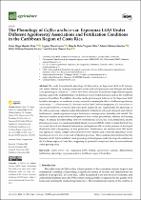Mostrar el registro sencillo del ítem
The Phenology of Coffea arabica var. Esperanza L4A5 Under Different Agroforestry Associations and Fertilization Conditions in the Caribbean Region of Costa Rica
| dc.contributor.author | Morales Peña, Victor Hugo | |
| dc.contributor.author | Mora Garcés, Argenis | |
| dc.contributor.author | Virginio Filho, Elias de Melo | |
| dc.contributor.author | Villatoro Sánchez, Mario | |
| dc.contributor.author | Pazmiño Pachay, Willy William | |
| dc.contributor.author | Chanto Ares, Esteban | |
| dc.date.accessioned | 2024-11-06T19:26:54Z | |
| dc.date.available | 2024-11-06T19:26:54Z | |
| dc.date.issued | 2024-11-06 | |
| dc.identifier.uri | https://repositorio.catie.ac.cr/handle/11554/12697 | |
| dc.description.abstract | This study focused on the phenology of Coffea arabica var. Esperanza L4A5, an F1 interspecific hybrid obtained by crossing commercial varieties with wild genotypes from Ethiopia and Sudan. Most phenological studies on C. arabica have been conducted in traditional high-altitude regions, leaving a gap in the understanding of its behavior in non-traditional areas such as the Caribbean region of Costa Rica. To establish a baseline on the phenological behavior of the Esperanza L4A5 hybrid in this region, we conducted a four-year study examining the effects of different agroforestry associations: (1) Albizia saman; (2) Hymenaea courbaril and Erythrina poeppigiana; (3) Anacardium excelsum and Erythrina poeppigiana; and coffee plots under full sun. Additionally, the phenology of the coffee plants was evaluated under differentiated fertilizations (physical, chemical, and without fertilization), considering meteorological factors such as temperature, humidity, and rainfall. The observed variables included the development of floral nodes, pre-anthesis, anthesis, and fruiting stages. To analyze the relationships between environmental factors, tree cover, fertilization, and the phenological stages, we employed multiple linear regression (MLR), which revealed that both tree cover and physical and chemical fertilizations had significant effects on the presence of developed floral nodes and, consequently, on fruit production. Furthermore, the random forest (RF) model was applied to capture complex interactions between variables and to rank the importance of meteorological factors, tree cover, and fertilization practices. These analyses demonstrated that the Esperanza L4A5 hybrid exhibited viable phenological development under the atypical conditions of the Caribbean region of Costa Rica, suggesting its potential to adapt and thrive in non-traditional coffee-growing areas. | es_ES |
| dc.format.extent | 21 páginas | es_ES |
| dc.language.iso | en | es_ES |
| dc.publisher | MDPI | es_ES |
| dc.relation.ispartof | Agriculture | es_ES |
| dc.relation.uri | https://doi.org/10.3390/agriculture14111988 | es_ES |
| dc.subject | Coffea arabica||Coffea arabica||Coffea arabica||Coffea arabica | es_ES |
| dc.subject | Híbrido||hybrids||híbrido||hybride | es_ES |
| dc.subject | Sistema agroforestal||agroforestry systems||sistemas agroflorestais||système agroforestier | es_ES |
| dc.subject | Abonos||fertilizers||fertilizante||engrais | es_ES |
| dc.subject | Fenología||phenology||Fenologia||phénologie | es_ES |
| dc.subject | Análisis de la regresión||regression analysis||análise de regressão||analyse de régression | es_ES |
| dc.subject | Costa Rica||Costa Rica||Costa Rica||Costa Rica | es_ES |
| dc.subject | Esperenza L4A5 | es_ES |
| dc.subject.other | Sede Central | es_ES |
| dc.title | The Phenology of Coffea arabica var. Esperanza L4A5 Under Different Agroforestry Associations and Fertilization Conditions in the Caribbean Region of Costa Rica | es_ES |
| dc.type | Artículo | es_ES |
| dc.identifier.status | openAccess | es_ES |


